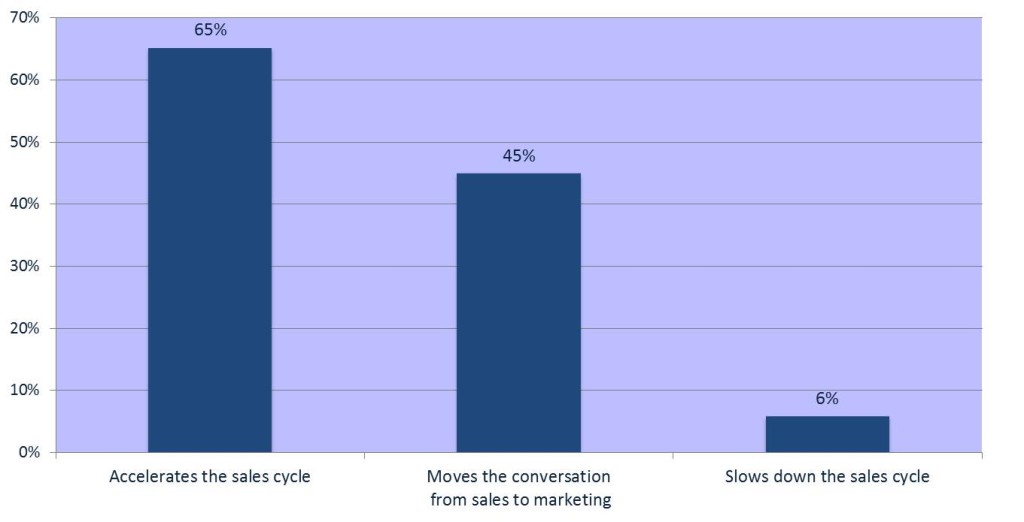 As part of our latest B2B survey of senior enterprise marketers, we asked, “How has social media changed the buyer’s journey?” Overwhelmingly (65%), respondents answered that social media has accelerated the sales cycle – see chart below.
As part of our latest B2B survey of senior enterprise marketers, we asked, “How has social media changed the buyer’s journey?” Overwhelmingly (65%), respondents answered that social media has accelerated the sales cycle – see chart below.
How has social media changed the buyer’s journey?
Naturally we pondered precisely how social media can be most effectively used to speed up sales – we came up with the following three key ways to leverage dynamic social platforms to find and engage prospects, while nurturing existing relationships:
1. FIND customers, prospects, influencers, and decision makers – This initial step has two primary goals: you want to further existing relationships with current customers, while engaging prospects to qualify them enough to pass onto sales. A good place to begin is by evaluating the profiles of existing customers and then seeking out prospective customers with similar profiles. Map relationships and hierarchies in prospective organizations to determine key influencers and decision makers. Look to social KPIs (likes, fans, followers, shares, etc.) to determine who the influencers are – both for existing customers and prospects – and see how you might leverage their social influence sphere. For influencers within prospective organizations, check who in their social network might facilitate an introduction. But also don’t discount those who may be influencing prospects and customers from outside their organizations.
2. LISTEN – Now that you’ve found your target audience, before engaging them, you might be best served by listening to their conversations. What are their pain points, concerns, and challenges? What are they reading? What are they sharing? What social platforms are they using most, and where are they seeking their information and conducting their research? Track conversations that mention your offerings, as well as those of your competitors. Monitoring social media provides visibility into what issues and challenges targeted accounts are inquiring about with their peers, gaining you valuable insight from which you can develop tailored messaging that is timely and relevant.
3. RESPOND – Speaking of timely and relevant, you want to use the listening capabilities you’ve developed to create remarkable content – content which gets shared and remarked on. Engage in conversations which pose questions about the current state of reality for which your solution is an answer. Create campaigns which illustrate how your solution is relevant. But a word of caution: social media is a great medium for making connections, building relationships, and promoting conversations regarding the issues and challenges your solution addresses – but it’s not the place to promote the solution itself. Your target audience isn’t that interested in your product or service per se – what they’re really interested in are the personal implications resulting from the use of your product or service. Conversation had around these implications or outcomes are far more welcome and successful than the tired sales pitch.
As you monitor social topics, be sure to keep sales up-to-date so they can react quickly to emerging needs, thereby increasing responsiveness to both customers and prospects. A recent Forbes article quote illustrates just how powerful this “real-time” responsiveness to social media postings can be for lead conversions:
“One tech company…tracked the appearance of certain key words on social platforms. When it noticed a decision maker from a prospect company asking a question online, it matched the question and the prospect’s location with a specific salesperson and sent along the lead, converting on these leads almost 80 percent of the time.”
B2B social media use can increase productivity by better understanding customer relationships, those people and issues influencing the conversation, gaining better insight into precisely what the hot-button issues are, and aligning closely with sales to be positioned to respond rapidly to emerging needs. Social media excels at promoting people and ideas, and can help refine your target audience, as well as your messaging to make stronger and timelier connections.
Of course, social media is also used by your prospective customer to enquire about the best solutions from their colleagues and peers. Once they have solid recommendations they can move quickly to invite their shortlist candidates and then close a deal. This is another way in which social media speeds the sales cycle. Unfortunately, it doesn’t allow for much interaction during the early phases of the purchase process, making it that much more important for vendors to be proactive in getting their message out to the influencers before they are asked for their opinions by peers.
How are you using social media to speed the sales cycle?

